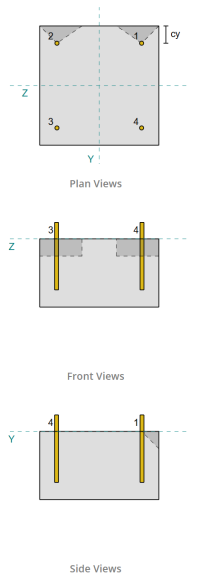ENを使用したベースプレートデザインの例 1993-1-8:2005, に 1993-1-1:2005, に 1992-1-1:2004, およびEN 1992-4:2018.
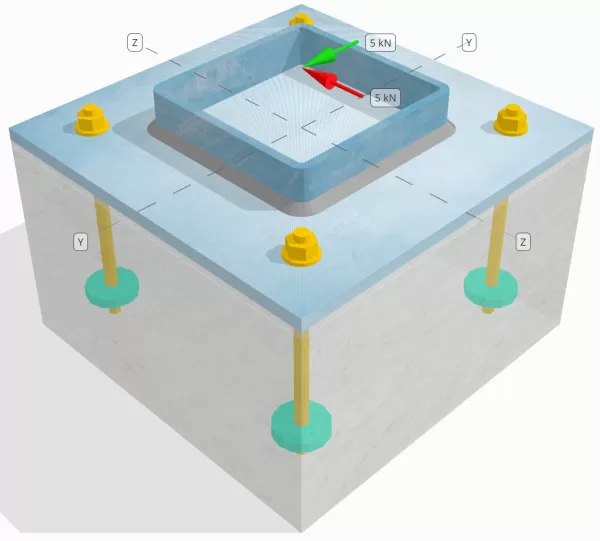
問題ステートメント
設計された柱とベース プレートの接続が十分な接続であるかどうかを判断します。 Vy=5-kN そして Vz=5-kN せん断荷重.
指定されたデータ
カラム:
列セクション: SHS 180x180x8
列エリア: 5440 んん2
列素材: S235
ベースプレート:
ベースプレートの寸法: 350 mm x 350 んん
ベースプレートの厚さ: 12 んん
ベースプレート材料: S235
グラウト:
グラウトの厚さ: 6 んん
Grout material: ≥ 30 MPa
コンクリート:
具体的な寸法: 350 mm x 350 んん
コンクリートの厚さ: 350 んん
コンクリート材料: C25/30
ひび割れまたは破損していません: 割れた
アンカー:
アンカーの直径: 12 んん
効果的な埋め込み長: 150 んん
埋め込まれたプレートの直径: 60 んん
埋め込まれたプレートの厚さ: 10 んん
アンカー素材: 8.8
その他の情報:
- カウンターサンクアンカー以外.
- カットスレッドを備えたアンカー.
- K7 factor for anchor steel shear failure: 1.0
- Degree of Restraint of Fastener: No restraint
溶接:
溶接タイプ: Fillet Weld
Weld leg size: 8んん
フィラー金属分類: E35
アンカーデータ (から SkyCIV計算機):
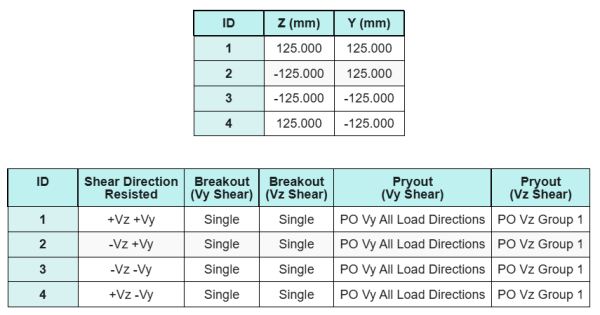
SkyCiv 無料ツールでモデルを作成する
無料のオンライン ツールを使用して、上記のベース プレート設計を今すぐモデル化してください。! サインアップは必要ありません.
定義
ロードパス:
の SkyCYVベースプレート設計ソフトウェア 続く に 1992-4:2018 for anchor rod design. Shear loads applied to the column are transferred to the base plate through the welds and then to the supporting concrete through the anchor rods. この例では、摩擦ラグとせん断ラグは考慮されていません。, これらのメカニズムは現在のソフトウェアではサポートされていないため、.
アンカーグループ:
The software includes an intuitive feature that identifies which anchors are part of an anchor group for evaluating コンクリートせん断ブレークアウト そして コンクリートせん断格子 障害.
アン アンカーグループ 投影された抵抗領域が重複する2つ以上のアンカーとして定義されます. この場合, アンカーは一緒に行動します, そして、それらの組み合わせ抵抗は、グループの適用された負荷に対してチェックされます.
あ シングルアンカー 投影抵抗領域が他のものと重複しないアンカーとして定義されます. この場合, アンカーは単独で作用します, そして、そのアンカーに加えられたせん断力は、個々の抵抗に対して直接チェックされます.
この区別により、せん断関連の故障モードを評価する際に、ソフトウェアがグループの動作と個々のアンカーパフォーマンスの両方をキャプチャできます。.
段階的な計算
小切手 #1: 溶接容量を計算します
私たちは、 Vz shear load is resisted by the top and bottom welds, ながら あなた shear load is resisted exclusively by the left and right welds.
To determine the weld capacity of the top and bottom welds, we first calculate their total weld lengths.
\(
L_{w,top\&底} = 2 \左(=最も近いサポートの面までのせん断が考慮されているセクションの距離{col} – 2t_{col} – 2r_{col}\正しい)
= 2 \倍左(180 \,\テキスト{んん} – 2 \回 8 \,\テキスト{んん} – 2 \回 4 \,\テキスト{んん}\正しい)
= 312 \,\テキスト{んん}
\)
次, を計算します stresses in the welds.
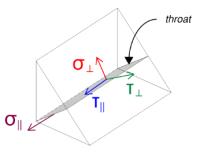
Note that the applied Vz shear acts parallel to the weld axis, with no other forces present. This means the perpendicular stresses can be taken as zero, and only the shear stress in the parallel direction needs to be calculated.
\(
\シグマ_{\perp} = frac{N}{(L_{w,top\&底})\,a\sqrt{2}}
= frac{0 \,\テキスト{kN}}{(312 \,\テキスト{んん}) \回 5.657 \,\テキスト{んん} \回 sqrt{2}}
= 0
\)
\(
\君の_{\perp} = frac{0}{(L_{w,top\&底})\,a\sqrt{2}}
= frac{0 \,\テキスト{kN}}{(312 \,\テキスト{んん}) \回 5.657 \,\テキスト{んん} \回 sqrt{2}}
= 0
\)
\(
\君の_{\平行} = frac{V_{と}}{(L_{w,top\&底})\,a}
= frac{5 \,\テキスト{kN}}{(312 \,\テキスト{んん}) \回 5.657 \,\テキスト{んん}}
= 2.8329 \,\テキスト{MPa}
\)
使用する に 1993-1-8:2005, Eq. 4.1, the design weld stress is obtained using the directional method.
\(
F_{w,エド1} = sqrt{ (\シグマ_{\perp})^ 2 + 3 \左( (\君の_{\perp})^ 2 + (\君の_{\平行})^2 右) }
= sqrt{ (0)^ 2 + 3 \倍左( (0)^ 2 + (2.8329 \,\テキスト{MPa})^2 右) }
= 4.9067 \,\テキスト{MPa}
\)
加えて, the design normal stress for the base metal check, あたり に 1993-1-8:2005, Eq. 4.1, is taken as zero, 以来 no normal stress is present.
\(
F_{w,エド2} = シグマ_{\perp} = 0
\)
今, let us assess the left and right welds. As with the top and bottom welds, we first calculate the 総溶接長.
\(
L_{w,left\&正しい} = 2 \左(d_{col} – 2t_{col} – 2r_{col}\正しい)
= 2 \倍左(180 \,\テキスト{んん} – 2 \回 8 \,\テキスト{んん} – 2 \回 4 \,\テキスト{んん}\正しい)
= 312 \,\テキスト{んん}
\)
We then calculate the components of the weld stresses.
\(
\シグマ_{\perp} = frac{N}{(L_{w,left\&正しい})\,a\sqrt{2}}
= frac{0 \,\テキスト{kN}}{(312 \,\テキスト{んん}) \回 5.657 \,\テキスト{んん} \回 sqrt{2}}
= 0
\)
\(
\君の_{\perp} = frac{0}{(L_{w,left\&正しい})\,a\sqrt{2}}
= frac{0 \,\テキスト{kN}}{(312 \,\テキスト{んん}) \回 5.657 \,\テキスト{んん} \回 sqrt{2}}
= 0
\)
\(
\君の_{\平行} = frac{v_y}{(L_{w,left\&正しい})\,a}
= frac{5 \,\テキスト{kN}}{(312 \,\テキスト{んん}) \回 5.657 \,\テキスト{んん}}
= 2.8329 \,\テキスト{MPa}
\)
使用する に 1993-1-8:2005, Eq. 4.1, we determine both the design weld stress and the design normal stress for the base metal check.
\(
F_{w,エド1} = sqrt{ \左( \シグマ_{\perp} \正しい)^ 2 + 3 \左( \左( \君の_{\perp} \正しい)^ 2 + \左( \君の_{\平行} \正しい)^2 右) }
\)
\(
F_{w,エド1} = sqrt{ \左( 0 \正しい)^ 2 + 3 \倍左( \左( 0 \正しい)^ 2 + \左( 2.8329 \,\テキスト{MPa} \正しい)^2 右) }
\)
\(
F_{w,エド1} = 4.9067 \,\テキスト{MPa}
\)
The next step is to identify the governing weld stress between the top/bottom welds and the left/right welds. Because the weld lengths are equal and the applied loads have the same magnitude, the resulting weld stresses are equal.
\(
F_{w,エド1} = \max(F_{w,エド1}, \, F_{w,エド1})
= \max(4.9067 \,\テキスト{MPa}, \, 4.9067 \,\テキスト{MPa})
= 4.9067 \,\テキスト{MPa}
\)
The base metal stress remains zero.
\(
F_{w,エド2} = \max(F_{w,エド2}, \, F_{w,エド2}) = \max(0, \, 0) = 0
\)
今, we calculate the weld capacity. 最初, the resistance of the すみ肉溶接 is computed. その後, the resistance of the base metal is determined. ENの使用 1993-1-8:2005, Eq. 4.1, the capacities are calculated as follows:
\(
F_{w,RD1} = frac{f_u}{\beta_w \left(\それを計算するために{M2,weld}\正しい)}
= frac{360 \,\テキスト{MPa}}{0.8 \回 (1.25)}
= 360 \,\テキスト{MPa}
\)
\(
F_{w,Rd2} = frac{0.9 f_u}{\それを計算するために{M2,weld}}
= frac{0.9 \回 360 \,\テキスト{MPa}}{1.25}
= 259.2 \,\テキスト{MPa}
\)
最後に, we compare the weld stresses with the weld capacities, and the base metal stresses with the base metal capacities.
以来 4.9067 MPa < 360 MPa そして 0 MPa < 259.2 MPa, the capacity of the welded connection is 十分な.
小切手 #2: vyせん断によるコンクリートブレイクアウト容量を計算します
Following the provisions of に 1992-4:2018, the edge perpendicular to the applied load is assessed for shear breakout failure. Only the anchors nearest to this edge are considered engaged, while the remaining anchors are assumed not to resist shear.
These edge anchors must have a concrete edge distance greater than the larger of 10·hef and 60·d, どこ 持っている is the embedment length and d is the anchor diameter. If this condition is not met, the thickness of the base plate must be less than 0.25·hef.
If the requirements in に 1992-4:2018, 句 7.2.2.5(1), are not satisfied, the SkyCiv software cannot proceed with the design checks, and the user is advised to refer to other relevant standards.

From the SkyCiv software results, the edge anchors act as シングルアンカー, since their projected areas do not overlap. この計算のために, アンカー 1 will be considered.
To calculate the portion of the Vy shear load carried by Anchor 1, the total Vy shear is distributed among the anchors nearest to the edge. これにより、 perpendicular force on Anchor 1.
\(
V_{\perp} = frac{v_y}{n_{a,s}}
= frac{5 \,\テキスト{kN}}{2}
= 2.5 \,\テキスト{kN}
\)
のために parallel force, it is assumed that all anchors resist the load equally. したがって, the parallel component of the load is calculated as:
\(
V_{\平行} = frac{V_Z}{n_{anc}}
= frac{5 \,\テキスト{kN}}{4}
= 1.25 \,\テキスト{kN}
\)
の 総せん断荷重 on Anchor 1 is therefore:
\(
V_{エド} = sqrt{ \左( V_{\perp} \正しい)^ 2 + \左( V_{\平行} \正しい)^ 2 }
\)
\(
V_{エド} = sqrt{ \左( 2.5 \,\テキスト{kN} \正しい)^ 2 + \左( 1.25 \,\テキスト{kN} \正しい)^ 2 } = 2.7951 \,\テキスト{kN}
\)
The first part of the capacity calculation is to determine the alpha and beta factors. 使用します に 1992-4:2018, 句 7.2.2.5, to set the lf dimension, そして 方程式 7.42 そして 7.43 to determine the factors.
\(
l_f = \min(h_{ef}, \, 12d_{anc})
= min(150 \,\テキスト{んん}, \, 12 \回 12 \,\テキスト{んん})
= 144 \,\テキスト{んん}
\)
\(
\alpha = 0.1 \左(\フラク{l_f}{c_{1,s1}}\正しい)^{0.5}
= 0.1 \倍左(\フラク{144 \,\テキスト{んん}}{50 \,\テキスト{んん}}\正しい)^{0.5}
= 0.16971
\)
\(
\beta = 0.1 \左(\フラク{d_{anc}}{c_{1,s1}}\正しい)^{0.2}
= 0.1 \倍左(\フラク{12 \,\テキスト{んん}}{50 \,\テキスト{んん}}\正しい)^{0.2}
= 0.07517
\)
The next step is to calculate the initial value of the characteristic resistance of the fastener. 使用する に 1992-4:2018, 方程式 7.41, the value is:
\(
V ^{0}_{Rk,c} = k_9 \left( \フラク{d_{anc}}{\テキスト{んん}} \正しい)^{\アルファ}
\左( \フラク{l_f}{\テキスト{んん}} \正しい)^{\ベータ}
\平方根{ \フラク{f_{ck}}{\テキスト{MPa}} }
\左( \フラク{c_{1,s1}}{\テキスト{んん}} \正しい)^{1.5} N
\)
\(
V ^{0}_{Rk,c} = 1.7 \倍左( \フラク{12 \,\テキスト{んん}}{1 \,\テキスト{んん}} \正しい)^{0.16971}
\倍左( \フラク{144 \,\テキスト{んん}}{1 \,\テキスト{んん}} \正しい)^{0.07517}
\回 sqrt{ \フラク{20 \,\テキスト{MPa}}{1 \,\テキスト{MPa}} }
\倍左( \フラク{50 \,\テキスト{んん}}{1 \,\テキスト{んん}} \正しい)^{1.5}
\回 0.001 \,\テキスト{kN}
\)
\(
V ^{0}_{Rk,c} = 5.954 \,\テキスト{kN}
\)
その後, 計算します 参照投影エリア of a single anchor, 以下 に 1992-4:2018, 方程式 7.44.
\(
A_{c,V }^{0} = 4.5 \左( c_{1,s1} \正しい)^ 2
= 4.5 \倍左( 50 \,\テキスト{んん} \正しい)^ 2
= 11250 \,\テキスト{んん}^ 2
\)
その後, 計算します 実際の投影エリア of Anchor 1.
\(
b_{c,V } = min(c_{左,s1}, \, 1.5c_{1,s1}) + \分(c_{正しい,s1}, \, 1.5c_{1,s1})
\)
\(
b_{c,V } = min(300 \,\テキスト{んん}, \, 1.5 \回 50 \,\テキスト{んん}) + \分(50 \,\テキスト{んん}, \, 1.5 \回 50 \,\テキスト{んん}) = 125 \,\テキスト{んん}
\)
\(
それを計算するために{c,V } = min(1.5c_{1,s1}, \, t_{コンク}) = min(1.5 \回 50 \,\テキスト{んん}, \, 200 \,\テキスト{んん}) = 75 \,\テキスト{んん}
\)
\(
A_{c,V } の場合、ベースの下部から壁の高さの半分{c,V } b_{c,V } = 75 \,\テキスト{んん} \回 125 \,\テキスト{んん} = 9375 \,\テキスト{んん}^ 2
\)
We also need to calculate the parameters for shear breakout. 使用します に 1992-4:2018, 方程式 7.4, to get the factor that accounts for the disturbance of stress distribution, 方程式 7.46 for the factor that accounts for the member thickness, そして 方程式 7.48 for the factor that accounts for the influence of a shear load inclined to the edge. These are calculated as follows:
\(
\psi_{s,V } = min left( 0.7 + 0.3 \左( \フラク{c_{2,s1}}{1.5c_{1,s1}} \正しい), \, 1.0 \正しい)
= min left( 0.7 + 0.3 \倍左( \フラク{50 \,\テキスト{んん}}{1.5 \回 50 \,\テキスト{んん}} \正しい), \, 1 \正しい)
= 0.9
\)
\(
\psi_{h,V } = max left( \左( \フラク{1.5c_{1,s1}}{t_{コンク}} \正しい)^{0.5}, \, 1 \正しい)
= max left( \左( \フラク{1.5 \回 50 \,\テキスト{んん}}{200 \,\テキスト{んん}} \正しい)^{0.5}, \, 1 \正しい)
= 1
\)
\(
\=最も近いサポートの面までのせん断が考慮されているセクションの距離{V } = \tan^{-1} \左( \フラク{V_{\平行}}{V_{\perp}} \正しい)
= \tan^{-1} \左( \フラク{1.25 \,\テキスト{kN}}{2.5 \,\テキスト{kN}} \正しい)
= 0.46365 \,\テキスト{作業}
\)
\(
\psi_{\アルファ,V } = max left(
\平方根{ \フラク{1}{(\cos(\=最も近いサポートの面までのせん断が考慮されているセクションの距離{V }))^ 2 + \左( 0.5 \, (\それなし(\=最も近いサポートの面までのせん断が考慮されているセクションの距離{V })) \正しい)^ 2 } }, \, 1 \正しい)
\)
\(
\psi_{\アルファ,V } = max left(
\平方根{ \フラク{1}{(\cos(0.46365 \,\テキスト{作業}))^ 2 + \左( 0.5 \times \sin(0.46365 \,\テキスト{作業}) \正しい)^ 2 } }, \, 1 \正しい)
\)
\(
\psi_{\アルファ,V } = 1.0847
\)
One important note when determining the alpha factor is to ensure the perpendicular shear and parallel shear are identified correctly.
最後に, 計算します breakout resistance of the single anchor using に 1992-4:2018, 方程式 7.1.
\(
V_{Rk,c} = V^0_{Rk,c} \左(\フラク{A_{c,V }}{A^0_{c,V }}\正しい)
\psi_{s,V } \psi_{h,V } \psi_{ec,V } \psi_{\アルファ,V } \psi_{再,V }
\)
\(
V_{Rk,c} = 5.954 \,\テキスト{kN} \倍左(\フラク{9375 \,\テキスト{んん}^ 2}{11250 \,\テキスト{んん}^ 2}\正しい)
\回 0.9 \回 1 \回 1 \回 1.0847 \回 1
= 4.8435 \,\テキスト{kN}
\)
Applying the partial factor, the design resistance is 3.23 kN.
\(
V_{Rd,c} = frac{V_{Rk,c}}{\それを計算するために{マク}}
= frac{4.8435 \,\テキスト{kN}}{1.5}
= 3.229 \,\テキスト{kN}
\)
以来 2.7951 kN < 3.229 kN, the shear breakout capacity for Vy shear is 十分な.
小切手 #3: VZせん断によるコンクリートブレイクアウト容量を計算します
The same approach is used to determine the capacity on the edge perpendicular to the Vz shear.

Because of the symmetric design, the anchors resisting Vz shear are also identified as シングルアンカー. 考えてみましょう アンカー 1 again for the calculations.
を計算するには perpendicular load on Anchor 1, we divide the Vz shear by the total number of anchors nearest to the edge only. を計算するには parallel load on Anchor 1, we divide the Vy shear by the total number of anchors.
\(
V_{\perp} = frac{V_{と}}{n_{a,s}}
= frac{5 \,\テキスト{kN}}{2}
= 2.5 \,\テキスト{kN}
\)
\(
V_{\平行} = frac{V_{そして}}{n_{anc}}
= frac{5 \,\テキスト{kN}}{4}
= 1.25 \,\テキスト{kN}
\)
\(
V_{エド} = sqrt{ \左( V_{\perp} \正しい)^ 2 + \左( V_{\平行} \正しい)^ 2 }
\)
\(
V_{エド} = sqrt{ \左( 2.5 \,\テキスト{kN} \正しい)^ 2 + \左( 1.25 \,\テキスト{kN} \正しい)^ 2 }
= 2.7951 \,\テキスト{kN}
\)
Using a similar approach to Check #2, 結果として生じる breakout resistance for the edge perpendicular to Vz shear is:
\(
V_{Rd,c} = frac{V_{Rk,c}}{\それを計算するために{マク}}
= frac{4.8435 \,\テキスト{kN}}{1.5}
= 3.229 \,\テキスト{kN}
\)
以来 2.7951 kN < 3.229 kN, the shear breakout capacity for Vz shear is 十分な.
小切手 #4: コンクリートのプリアウト容量を計算します
の計算 shear pryout resistance involves determining the nominal capacity of the anchors against tension breakout. The reference for tension breakout capacity is に 1992-4:2018, 句 7.2.1.4. A detailed discussion of tension breakout is already covered in the SkyCiv Design Example with Tension Load and will not be repeated in this design example.
From the SkyCiv software calculations, the nominal capacity of the section for tension breakout is 44.61 kN.
次に、使用します に 1992-4:2018, Equation 7.39a, to obtain the design characteristic resistance. 使用する k8 = 2, the capacity is 59.48 kN.
\(
V_{Rd,cp} = frac{k_8 N_{cbg}}{\gamma_c}
= frac{2 \回 44.608 \,\テキスト{kN}}{1.5}
= 59.478 \,\テキスト{kN}
\)
In the shear pryout check, all anchors are effective in resisting the full shear load. From the image generated by the SkyCiv software, all failure cone projections overlap with each other, making the anchors act as an アンカーグループ.

したがって, the required resistance of the anchor group is the total resultant shear load of 7.07 kN.
\(
V_{res} = sqrt{(v_y)^ 2 + (V_Z)^ 2}
= sqrt{(5 \,\テキスト{kN})^ 2 + (5 \,\テキスト{kN})^ 2}
= 7.0711 \,\テキスト{kN}
\)
\(
V_{エド} = left(\フラク{V_{res}}{n_{anc}}\正しい) n_{a,G1}
= left(\フラク{7.0711 \,\テキスト{kN}}{4}\正しい) \回 4
= 7.0711 \,\テキスト{kN}
\)
以来 7.0711 kN < 59.478 kN, the shear pryout capacity is 十分な.
小切手 #5: アンカーロッドのせん断耐力を計算する
The calculation of the anchor rod shear capacity depends on whether the shear load is applied with a moment arm. これを決定します, 参照します に 1992-4:2018, 句 6.2.2.3, where the thickness and material of the grout, the number of fasteners in the design, the spacing of the fasteners, and other factors are checked.
の SkyCYVベースプレート設計ソフトウェア performs all the necessary checks to determine whether the shear load acts with or without a lever arm. For this design example, it is determined that the shear load is ない applied with a lever arm. したがって, を使用しております に 1992-4:2018, 句 7.2.2.3.1, for the capacity equations.
We begin by calculating the characteristic resistance of the steel fastener using に 1992-4:2018, 方程式 7.34.
\(
V^0_{Rk,s} = k_6 A_s f_{あなた,anc}
= 0.5 \回 113.1 \,\テキスト{んん}^2 Times 800 \,\テキスト{MPa}
= 45.239 \,\テキスト{kN}
\)
次, we apply the factor for the 延性 of the single anchor or the anchor group, taking k7 = 1.
\(
V_{Rk,s} = k_7 V^{0}_{Rk,s}
= 1 \回 45.239 \,\テキスト{kN}
= 45.239 \,\テキスト{kN}
\)
We then obtain the partial factor for steel shear failure を使用して に 1992-4:2018, テーブル 4.1. For an anchor with 8.8 素材, the resulting partial factor is:
\(
\それを計算するために{MS,剪断}
= max left( 1.0 \左( \フラク{F_{あなた,anc}}{F_{そして,anc}} \正しい), \, 1.25 \正しい)
= max left( 1 \[object Window]{800 \,\テキスト{MPa}}{640 \,\テキスト{MPa}}, \, 1.25 \正しい)
= 1.25
\)
Applying this factor to the characteristic resistance, the design resistance is 36.19 kN.
\(
V_{Rd,s} = frac{V_{Rk,s}}{\それを計算するために{MS,剪断}}
= frac{45.239 \,\テキスト{kN}}{1.25}
= 36.191 \,\テキスト{kN}
\)
の required shear resistance per anchor rod is the resultant shear load divided by the total number of anchor rods, which calculates to 1.77 kN.
\(
V_{エド} = frac{\平方根{ (v_y)^ 2 + (V_Z)^ 2 }}{n_{anc}}
\)
\(
V_{エド} = frac{\平方根{ (5 \,\テキスト{kN})^ 2 + (5 \,\テキスト{kN})^ 2 }}{4}
= 1.7678 \,\テキスト{kN}
\)
以来 1.7678 kN < 36.191 kN, the anchor rod steel shear capacity is 十分な.
小切手 #6: Calculate base plate bearing capacity
追加の base plate bearing resistance check was introduced in a later update of the software. お願いします refer to this link for a sample calculation and detailed explanation.
設計の概要
の SkyCYVベースプレート設計ソフトウェア このデザインの例の段階的な計算レポートを自動的に生成できます. また、実行されたチェックとその結果の比率の概要も提供します, 情報を一目で理解しやすくします. 以下はサンプルの概要表です, レポートに含まれています.
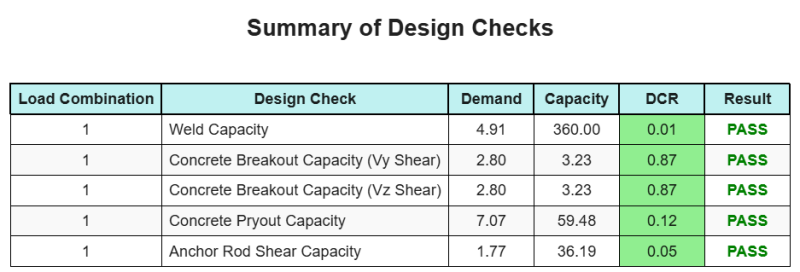
SkyCIVサンプルレポート
SkyCiv ベース プレート設計レポートから期待できる詳細レベルと明瞭さのレベルを確認してください。. The report includes all key design checks, 方程式, 結果は明確で読みやすい形式で表示されます. It is fully compliant with design standards. SkyCiv ベース プレート カリキュレーターを使用して生成されたサンプル レポートを表示するには、以下をクリックしてください。.
ベースプレートソフトウェアを購入します
他のSkyCIVモジュールなしで、ベースプレートデザインモジュールのフルバージョンを単独で購入する. これにより、ベースプレートデザインの完全な結果が得られます, 詳細なレポートとその他の機能を含む.

